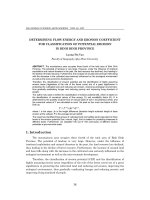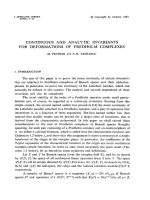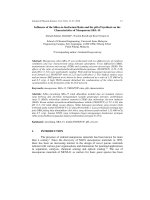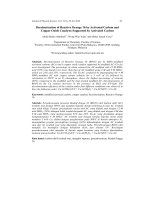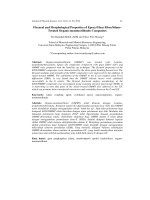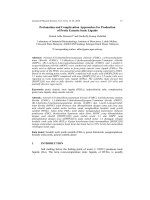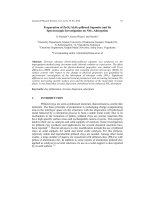Báo cáo vật lý: "Protonation and Complexation Approaches for Production of Protic Eutectic Ionic Liquids" ppsx
Bạn đang xem bản rút gọn của tài liệu. Xem và tải ngay bản đầy đủ của tài liệu tại đây (194.79 KB, 14 trang )
Journal of Physical Science, Vol. 21(1), 15–28, 2010 15
Protonation and Complexation Approaches for Production
of Protic Eutectic Ionic Liquids
Ahmad Adlie Shamsuri* and Dzulkefly Kuang Abdullah
Laboratory of Industrial Biotechnology, Institute of Bioscience, Lebuh Silikon,
Universiti Putra Malaysia, 43400 UPM Serdang, Selangor Darul Ehsan, Malaysia
*Corresponding author:
Abstract: 4-formyl-N,N-dimethylbenzenaminium chloride (FDBC), carboxymethanami-
nium chloride (CMAC), 1,3-dihydroxy-2-(hydroxymethyl)propan-2-aminium chloride
(DHPC), (R)-1-carboxy-2-mercaptoethanaminium chloride (CMEC) and 1-methyl-2-
oxopyrrolidinium chloride (MOPC) were synthesised and complexed with either urea or
oxalic acid at different molar ratios to form protic eutectic ionic liquids (PEILs). The
melting point of the PEILs was measured using differential scanning calorimetry (DSC).
Based on the melting point results, MOPC complexed with oxalic acid ([MOPC][O]) at a
1:1 molar ratio and DHPC complexed with urea ([DHPC][U]) at a 1:2 molar ratio were
regarded as room temperature ionic liquids (RTILs). The solubility study showed that
[MOPC][O] was able to fully dissolve soluble starch and rice starch (10 wt%) and
partially dissolve sago starch.
Keywords: protic eutectic ionic liquids (PEILs), hydrochloride salts, complexation,
protic ionic liquids, deep eutectic solvent
Abstrak: 4-formil-N,N-dimetilbenzenaminium klorida (FDBC), karboksimetana minium
klorida (CMAC), 1,3-dihidroksi-2-(hidroksimetil)propan-2-aminium klorida (DHPC),
(R)-1-karboksi-2-merkaptoetanaminium klorida (CMEC) dan 1-metil-2-oksopirrolidi-
nium klorida (MOPC) telah disintesis dan dikomplekskan dengan sama ada urea atau
asid oksalik pada nisbah molar berbeza untuk menghasilkan bendalir ionik protik
eutektik (PEILs). Takat lebur PEILs telah diukur menggunakan kalorimeter imbasan
pembezaan (DSC). Berdasarkan keputusan takat lebur, MOPC yang dikomplekskan
dengan asid oksalik ([MOPC][O]) pada nisbah molar 1:1 dan DHPC yang
dikomplekskan dengan urea ([DHPC][U]) pada nisbah molar 1:2 dianggap sebagai
bendalir ionik suhu bilik (RTILs). Kajian keterlarutan kanji menunjukkan [MOPC][O]
mampu melarutkan sepenuhnya kanji larut dan kanji beras (10% berat) dan melarutkan
sebahagian kanji sagu.
Kata kunci: bendalir ionik protik eutektik (PEILs), garam hidroksida, pengkompleksan,
bendalir ionik protik, pelarut eutektik dalam
1. INTRODUCTION
Salt melting below the boiling point of water (< 100°C) produces ionic
liquids (ILs). The term room-temperature ionic liquids, or RTILs, is usually
Production of Protic Eutectic Ionic Liquids 16
reserved for ionic melts with melting points below room temperature. ILs form
liquids that consist only of cations and anions. ILs are usually characterised by a
reasonable ionic conductivity (similar to most non-aqueous electrolytes). ILs'
extremely low vapour pressure is non-volatile, and ILs are highly polar, miscible
with certain organic solvents and/or water, and have good solubility with organic
and inorganic materials. They are also chemically inert, reusable and can be
designed, nonflammable and thermally stable as well.
1–3
ILs is promising and
environmentally benign, and have numerous reaction media which are expected
to provide an attractive alternative to conventional volatile organic compounds
(VOC). Nevertheless, in the last few years, they have become more attractive in
other fields, such as catalysis,
4
basic electro-chemical studies of organic and
inorganic compounds
5
, formation of metal nanostructures,
6
analytical chemistry
7
including sensors,
8
bio-analytical chemistry,
9
and electro-chemical biosensors.
10
The majority of investigations have concentrated on imidazolium cations
with discrete anions, such as BF
4
–
, PF
6
–
and (F
3
CSO
2
)
2
N
–
.
11
There are several
simulations and experimental studies mainly concerning the structure of
imidazolium-based ILs; the main conclusions are that those liquids are micro-
biphasic systems composed of polar and non-polar domains.
12
However, the use
of these types of ILs includes several disadvantages, such as toxicity and cost,
making them somewhat impractical for larger industrial applications, such as
metal electroplating, electrodeposition, and bio-catalyses. Therefore, the key
challenges in the application research of ILs have been the availability and cost
issues. Myriad issues, such as toxicity and availability, will limit ILs' practical
uses for larger scale applications of other metals and bio-materials. Although a
multitude of recipes has been published to carry out the synthesis of ILs, not all
laboratories focused on applied research have the expertise, work practices and
equipment necessary to carry out synthesis work due to the complicated synthetic
processes that are involved. In addition, to prepare pure, dried ILs, or to execute
post-synthesis purification, the steps are often challenging. On the other hand, the
commercial availability of some ILs is restricted to small volumes, or the cost of
many liquids is still unacceptable for applied engineering research.
13
The physical
and chemical properties of ILs can be influenced significantly by small amounts
of impurities. The catalytic activity and electro-chemical behaviour is highly
dependent on the purity level of the ILs. The quality of ILs has become an
important consideration in their use. Commercial producers try to make ILs of
the highest quality achievable at reasonable cost. Typical impurities include
organic starting materials and other volatiles, halide impurities, other ionic
impurities from incomplete metathesis reactions, and water. Analysis and trace
analysis of impurities in ILs is still a field of ongoing fundamental research.
14
During our investigations, we have found that the synthesis and
applications of primary and tertiary ammonium halide salts is much less than the
information concerning the hydrochloride salts that are related to the preparation
Journal of Physical Science, Vol. 21(1), 15–28, 2010 17
of ILs. For that reason, the concept of hybrids protonation, and the complexation
of nitrogen-based organic compounds, have been utilised. From economic and
environmental points of view, the protonation of nitrogen-based organic
compounds has attracted great attention from a wide range of organic chemists
over the last two decades. Altering insoluble nitrogen-based compounds into
hydrochloride salts is a common way to make them water- and acid-soluble
substances that are usually used in medications. Combinations of hydrochloride
salt and complexing agents to form ILs have never been reported before. In this
study, we produced protic eutectic ionic liquids (PEILs), a subgroup of the ILs
family that is a protic eutectic mixture of hydrochloride salts and complexing
agents (hydrogen bond donors like urea or oxalic acids) in a specific molar ratio.
PEILs are air and water stable and have the high conductivity needed for electro-
chemical applications. Here as a part of our study on environmentally friendly
ILs synthesis, we would like to report an operationally simple, inexpensive and
efficient preparation of novel PEILs. Aminobenzaldehyde, amino acids,
hydroxymethyl amine, amino acid thiol side chains and cyclic amide reactants
offer an attractive alternative for studying the ability to generate ILs that are cost
effective.
In a comparison with the traditional ILs synthesised by metathesis or ion
exchange,
15,16
PEILs were prepared by means of protonation and complexation,
making them more flexible alternatives to conventional ILs. It was reported
17
that
urea and oxalic acid-based ILs complexed with anions including chloride or
iodide seem to be promising for the low melting point ILs that incorporate
complexing agents. The idea exploited here is using hydrochloric acids as proton-
rich electrolytes for proton carrying media. Without a doubt, PEILs are potential
candidates for non-volatile ILs based on electrolyte syntheses, since they possess
many benefits that traditional ILs, based on imidazolium salts, do not have.
Moreover, they are easy to synthesise; the components of the eutectic can be
easily mixed and converted to ILs without further purification. Besides, they are
very cheap due to the low cost of raw materials. Its most important features,
which make it a suitable IL for large-scale applications, are its low cost and ease
of preparation as compared to other air- and water-stable ILs based on
imidazolium or pyridinium salts. Moreover, as compared to conventional ILs,
they share many characteristics; only ionic mixtures, not ionic compounds, are
known to be less toxic, air- and moisture-stable, biodegradable and economically
viable for large-scale processes. In this study, thermal characterisation conducted
by differential scanning calorimetry (DSC) and solubility tests consumed bio-
polymer like starch were also studied.
Production of Protic Eutectic Ionic Liquids 18
2. EXPERIMENTAL
2.1 Materials
4-dimethylaminobenzaldehyde, 2-aminoacetic acid, tris(hydroxymethyl)-
aminomethane, (2R)-2-amino-3-sulfanyl-propanoic acid and 1-methylpyrrolidin-
2-one were supplied by Sigma Aldrich (USA). Hydrochloric acid (HCl) was
purchased from R&M Chemicals (fuming ~ 37%). Urea and oxalic acid were also
obtained from Sigma Aldrich (USA). All of the chemicals' purity exceeded 99%
and the chemicals were used as they were received. The chemical structure of the
reactants is shown in Figure 1.
O
N
4-dimethylaminobenzaldehyde
H
2
N
O
OH
2-aminoacetic acid
H
2
N
HO
OH
H
O
tris(hydroxymethyl)aminomethane
H
2
N
S
H
O
OH
(2R)-2-amino-3-sulfanyl-propanoic acid
N
O
1-methylpyrrolidin-2-one
Figure 1: Reactants used for preparing PEILs.
2.2 Preparation of Hydrochloride Salts
4-dimethylaminobenzaldehyde, 2-aminoacetic acid, tris(hydroxymethyl)-
aminomethane, (2R)-2-amino-3-sulfanyl-propanoic acid and 1-methylpyrrolidin-
Journal of Physical Science, Vol. 21(1), 15–28, 2010 19
2-one were dissolved in distilled water and stirred. Equimolar amounts of HCl
and the reactant solution were allowed to react during the stirring process for one
hr in a rotary evaporator at an ambient temperature, followed by at an elevated
temperature (85ºC). Distilled water was then removed by distillation under
reduced vacuum pressure. The unreacted HCl was evaporated and any unreacted
reactant was removed under a vacuum from the solid, which obtained a yield of
over 80%. The hydrochloride salts were then collected and kept dry in a vacuum
oven at 85ºC overnight. The products are 4-formyl-N,N-dimethylbenzenaminium
chloride (FDBC), carboxymethanaminium chloride (CMAC), 1,3-dihydroxy-2-
(hydroxymethyl)propan-2-aminium chloride (DHPC), (R)-1-carboxy-2-
mercaptoethanaminium chloride (CMEC) and 1-methyl-2-oxopyrrolidinium
chloride (MOPC) hydrochloride salts. All of the hydrochloride salts were
recrystallised from ethanol and then rigorously dried in the vacuum oven and
kept under silica gels prior to use. The chemical structure of the synthesised
hydrochloride salts is shown in Figure 2.
O
NH
Cl
-
4-formyl-N,N-dimethylbenzenaminium
chloride (FDBC)
H
3
N
O
OH
Cl
-
carboxymethanaminium chloride (CMAC)
H
3
N
HO
OH
H
O
Cl
-
1,3-dihydroxy-2-(hydroxymethyl)-
propan-2-aminium chloride (DHPC)
H
3
N
SH
O
OH
Cl
-
(R)-1-carboxy-2-mercaptoethanaminium
chloride (CMEC)
Figure 2: Hydrochloride salts prepared by protonation (continued on next page).
Production of Protic Eutectic Ionic Liquids 20
NH
O
Cl
-
1-methyl-2-oxopyrrolidinium chloride (MOPC)
Figure 2: (continued).
2.3 Preparation of Protic Eutectic Ionic Liquids (PEILs)
The PEILs were prepared using a typical preparation procedure: intact
FDBC, CMAC, DHPC, CMEC or MOPC was placed into a rotary evaporator
flask and mixed slowly with urea or oxalic acid at a 0.5, 1, 2 and 3 molar ratio.
The mixture was kept under rotating conditions by heating with an elevated
temperature (85ºC) under vacuum pressure until a homogeneous liquid appeared.
If no liquid appeared, heating and rotating were continued up to an additional
period of seven hours. Then, the reaction mixture was dried overnight at 85°C in
a vacuum oven to obtain the final product prior to differential scanning
calorimetry (DSC) thermal analysis. The resultants, FDBC, CMAC, DHPC,
CMEC and MOPC, when complexed with urea acid abbreviated as [FDBC][U],
[CMAC][U], [DHPC][U], [CMEC][U], and [MOPC][U] and when complexed
with oxalic acid is abbreviated as [FDBC][O], [CMAC][O], [DHPC][O],
[CMEC][O] and [MOPC][O]. The PEILs were dried in a vacuum oven prior to
use.
2.4 Characterisation
DSC analysis was conducted on a Mettler Toledo DSC822
e
apparatus
under nitrogen flow using the Software Tools for Academics and Researchers
(STAR) analysis software. The samples were tightly sealed in aluminium pans.
All of the samples were subjected to the following procedures. The samples were
first heated to 100°C to eliminate their thermal history. The experiments were
carried out in a temperature range of –60°C to 450ºC with a cooling and heating
rate of 10°C/min to obtain the melting point, T
m
, which was determined from the
DSC thermograms during the programmed reheating steps. The temperatures that
are reported from the DSC data are curved peaks; melting points being
endothermic upon heating. All of the samples were dried in a vacuum oven for at
least 24 hr prior to the DSC measurements.
Journal of Physical Science, Vol. 21(1), 15–28, 2010 21
2.5 Solubility Test
To characterise the capability of PEILs of being able to dissolve organic
compounds, especially bio-polymers (such as starch), three types of bio-polymers
that is soluble starch, rice starch and sago starch were dissolved into prepared
PEILs. The solubility was measured using mixed starches with PEILs in a 100 ml
rotavapor flask. The flask was immersed in a water bath at 70ºC and rotated for at
least 3 hr. The starch and PEILs were fixed to a 10 wt% of starches, with the rest
being PEILs. The solution was observed visually, and, if the solution appeared
unsatisfactory, heating and stirring was continued up to 12 hr.
3. RESULTS AND DISCUSSION
3.1 Physical Appearance
Table 1 shows the appearance profiles of the hydrochloride salts at room
temperature (25°C). All of the prepared hydrochloride salts are solid at ambient
temperature, corresponding to the physical properties of simple salts. Table 2
shows the appearances of the PEILs, where the numbers represent the molar ratio
of the hydrochloride salts and the complexing agent binary system.
Because the hydrochloride salts are composed of organic cations and
chloride ions, they appear to form a liquid at elevated temperatures with the
appropriate molar ratio of the complexing agent. It seems that the complexation
reaction occurred in which urea or oxalic acid completed complexation with the
chloride ions. As can also be seen in Table 2, the protic eutectic of hydrochloride
salt with a 2:1 molar ratio of urea to oxalic acid content was in the liquid state.
However, as the content of the complexing agent reached either less or more than
those molar ratios, the solid state appeared. Hydrogen bonding between the
chloride ions with the complexing agent causes the liquid state to appear.
17
Table 1: Appearances of hydrochloride salts at room temperature (25°C).
Hydrochloride salt Appearance
FDBC Yellow to green solid
CMAC Pale green solid
DHPC White solid
CMEC White solid
MOPC Yellow solid
Production of Protic Eutectic Ionic Liquids 22
Table 2: Appearance of PEILs with several molar ratio at 85°C.
Ratio
(complexing agent:PEIL)
Appearance
PEIL
Urea Oxalic acid Urea Oxalic acid
FDBC 0.5:1 0.5:1 Solid Solid
1:1 1:1 Solid Liquid
2:1 2:1 Liquid Solid
3:1 3:1 Solid Solid
CMAC 0.5:1 0.5:1 Solid Solid
1:1 1:1 Solid Solid
2:1 2:1 Liquid Solid
3:1 3:1 Solid Solid
DHPC 0.5:1 0.5:1 Solid Solid
1:1 1:1 Liquid Liquid
2:1 2:1 Liquid Solid
3:1 3:1 Solid Solid
CMEC 0.5:1 0.5:1 Solid Solid
1:1 1:1 Liquid Solid
2:1 2:1 Liquid Solid
3:1 3:1 Solid Solid
MOPC 0.5:1 0.5:1 Solid Solid
1:1 1:1 Solid Liquid
2:1 2:1 Liquid Liquid
3:1 3:1 Solid Solid
3.2 DSC Thermal Analysis
DSC is a well known technique which gives an exhaustive overview of
the relevant thermal analysis.
18
Table 3 shows the melting points of the reactants
that were supplied by Sigma Aldrich MSDS (USA). Table 4 shows the melting
points of the complexing agents, which were also supplied by Sigma Aldrich
MSDS, which are solid at ambient temperature. The calorimetric data were
obtained by heating and cooling the hydrochloride salts sample as shown in Table
5. Each melting point of the DSC traces represents a crystalline melting point for
the hydrochloride salts. It can be observed that the melting points of the
hydrochloride salts are significantly lower than the melting points of the reactants
due to the higher decomposition potential of the reactants substance at high
temperatures. Nevertheless, in this study, many of these hydrochloride salts have
a melting point above 150°C. Mostly, the nitrogen constituent was protonated
with the hydrogen ion so as to produce nitrogen ions bound with the hydrogen
itself. In protonation, the nitrogen constituent phenomenon by strong acid
neutralises the compound, and it created positive and negative ions that are
regarded as protic ILs.
19
Journal of Physical Science, Vol. 21(1), 15–28, 2010 23
Table 3: Reactant melting points as determined from literature data.
Reactants Melting point, T
m
(°C)
4-dimethylaminobenzaldehyde 72–75
a
2-aminoacetic acid 240
a
tris(hydroxymethyl)aminomethane 167–172
a
(2R)-2-amino-3-sulfanyl-propanoic acid >240
a
1-methylpyrrolidin-2-one –24
a
Note:
a
obtained from Sigma Aldrich
Table 4: Melting points of complexing agent as determined from literature data.
Complexing agent Melting point, T
m
(°C)
Urea 132–135
b
oxalic acid 189.5
b
Note:
b
obtained from Sigma Aldrich
Table 5: Hydrochloride salts melting point as determined from DSC data.
Hydrochloride salt Melting point, T
m
(ºC)
FDBC 44.60
CMAC 180.23
DHPC 157.41
CMEC 251.46
MOPC 50.17
The DSC data for the PEILs were taken for appropriate molar ratios of
the complexing agent (two for urea and one for oxalic acid) owing to the
appearances of the PEILs that, overall, were dilute liquids at 85ºC. All of the
melting points corresponding with the peaks of DSC traces are listed in Table 6.
It is important to relate the structure of the mixture to the physical properties of
the compound; in the hydrochloride salts phase, the Coulomb interactions
between cations and anions are generally stronger. As a result, compounds in
these structures tend to have higher melting points than those between the atomic
cations and anions of the PEILs compound. In the PEIL phase, an eutectic
compound forms due to hydrogen bonding interactions between the complexing
agent and the anions. Because it consists of nitrogen cations and anions, these
structures separate cations from anions owing to the large radius ratios and these
structures also provide weak interactions. Therefore, enhanced quantities of
nitrogen cations and anions are produced with complex species. The increased
stabilisation of the liquid state also decreased the kinetics of the crystallisation
process, and, in this system, it leads to the possibility of lower melting points
given the low temperature of molten salts.
Production of Protic Eutectic Ionic Liquids 24
Table 6: PEILs melting points as determined from DSC data for 1:2 molar ratio
of hydrochloride salt:urea and 1:1 molar ratio of hydrochloride
salt:oxalic acid.
PElLs Melting point, T
m
(°C)
[FDBC][U] 39.25
[FDBC][O] 103.10
[CMAC][U] 86.62
[CMAC][O] 164.91
[DHPC][U] 18.72
[DHPC][O] 65.07
[CMEC][U] 61.14
[CMEC][O] 150.20
[MOPC][U] 87.23
[MOPC][O] –14.08
Note: U = urea, O = oxalic acid
In addition, PEILs' melting points also decrease with the larger, more
asymmetric nitrogen cations, in which the highest melting points are observed for
the more symmetric nitrogen cations. The highest melting point exists for CMEC,
with the primary nitrogen cation that has the thiol side chain. With the thiol side
chain, the melting point increases to a value above that observed for the
hydrochloride salt. The lower melting point is observed with [MOPC][O] due to
the larger size of the cations providing greater degrees of freedom and
asymmetry. The hydrochloride salts containing the cyclic cation have lower
melting points for the PEILs, as compared to the other primary or tertiary cations
investigated. The ring hydrochloride salts display greater ILs, probably due to the
presence of the methyl group in one position in the MOPC ring which enhances
the asymmetry of the cation.
20
Furthermore, it has been proposed that the anion in
the ILs entity is the chloride ions complexed by the hydrogen bond donor that
leads to a charge delocalisation, effectively decreasing the melting point.
21
Apart from that, PEILs show clear endothermic activity, indicating a
melting point below 200°C. When a complexing agent was added, the
endothermic activity shifted to lower temperatures. When the hydrochloride salts
were either DHPC or MOPC, as was appropriate for the complexing agent and
the molar ratio, the melting point rapidly shifted to a lower room temperature. In
contrast, on complexation with urea or oxalic acid, which increases the molar
ratio, no obvious low melting point was observed in this temperature range when
the complexing agent content was over two for molar ratio of urea, and one for
molar ratio of oxalic acid. The existence of this transparent liquid may indicate
that the liquids are homogenous, whereas they are otherwise indicated as
heterogeneous. The liquids were found to be homogeneous mixtures of the two
components, and precise hydrogen bonding formed through the complexation
reaction.
Journal of Physical Science, Vol. 21(1), 15–28, 2010 25
In contrast, the existence of the solid may suggest that the yield is
partially distributed despite the crystallisation of the liquids. From this result, the
melting point of [DHPC][U] and [MOPC][O] in the complexing agents is
different from the melting point of DHPC and MOPC. The DSC results appear to
relate to the appearance differences among each resultant liquid. In other words,
the highest of the melting points may suggest the existence of strong ion coupling
in the mixture. Improved chemical stability for the liquid is possible because of
the increased thermodynamic stability of the anion complexes, which are
generally held together by strong chemical bonds.
22
Additionally, the hydrogen groups of the two hydrogen bond donor
complexing agents are attached to a relatively more electronegative atom than the
chloride ion of the hydrochloride salts, which should favour their complexation.
The complexation of hydrochloride salts is driven by a relatively strong hydrogen
bond between the chloride ion and the hydrogens in the complexing agent, in
particular with the relatively protic ones. When the complexing agent either
exceeded or was less than those compositions, crystallisation was achieved, and
the efficiencies of forming liquids were lower. However, in the [DHPC][U] and
[MOPC][O], by increasing the amount of the complexing agent, compounds that
tended to be solid were limited, and only caused the substance to become more
viscous. Thus, the optimum composition of the complexing agent is evidently
one of the key factors which determine the ideal complexation reaction. For this
reason, this study indicated the feasibility of using the urea and oxalic acid as
complexing agents for the development of ILs.
3.3 Solubility Test
Recently, ILs have been shown to dissolve and stabilise proteins
23
and to
be soluble in cellulose.
24
From Table 7, the solubility test results showed that the
low melting points of PEILs were very significant in dissolving the starches, even
in a partial state. The results exposed that [FDBC][U] and [DHPC][U] were
partially solubilised in the soluble starch (5 wt% starches), but could not be
dissolved in the rice starch and the sago starch. [MOPC][O] was able to be fully
solubilised in the soluble and rice starches, and partially solubilised in the sago
starch. The solubility test also indicated that the presence of heat dramatically
improved solubility. Even though the room temperature PEILs could not be
dissolved in the cellulose, the [MOPC][O] is a potential solvent for solubilised
starch, as compared to common organic solvents.
Production of Protic Eutectic Ionic Liquids 26
Table 7: Solubility of starches in PEILs as determined visually.
PEILs Soluble starch Rice starch Sago starch
[FDBC][U] Partially No No
[FDBC][O] No No No
[CMAC][U] No No No
[CMAC][O] No No No
[DHPC][U] Partially No No
[DHPC][O] No No No
[CMEC][U] No No No
[CMEC][O] No No No
[MOPC][U] No No No
[MOPC][O] Fully Fully Partially
4. CONCLUSION
Five types of nitrogen-based organic compounds—aminobenzaldehyde,
amino acid, hydroxymethyl amine, the amino acid thiol side chain and cyclic
amide—were used in this study. FDBC, CMAC, DHPC, CMEC, and MOPC
were synthesised using HCl to produce hydrochloride salts. Then, either urea or
oxalic acid were used as complexing agents to form PEILs.
From the DSC results, [MOPC][O] (MOPC complexed with oxalic acid
in a 1:1 molar ratio) with a melting point of –14.08°C, and [DHPC][U] (DHPC
complexed with urea in a 1:2 molar ratio) with a melting point of 18.72°C, were
considered as room temperature ionic liquids (RTILs). The molar ratios of the
complexing agent reveal that a double molar ratio of urea and an equimolar of
oxalic acid produced PEILs. PEILs were successfully formed by using
combinations of hydrochloride salts and complexing agents. HCl acts as a
protonater to produce protic hydrochloride salts. It has been shown that
hydrochloride salts could form complexes with hydrogen bond donors (urea or
oxalic acid). Based on the dissolution of starch, [MOPC][O] was the best
compound to dissolve starch as compared to the others. The appropriate molar
ratio of the complexing agents created the proper nitrogen-based organic
compounds to form PEILs, further complexing the agents' content, and, thus,
the solid appearance were observed. The ILs were successfully produced
by protonation and the complexation technique for aminobenzaldehyde,
hydroxymethyl amine and cyclic amide systems. The physical and chemical
properties of PEILs are congruent to those of the traditional ILs, but the range of
structures for PEILs is likely to be different from that of ILs which are
constituted only by discrete ions. Hence, this study can be applied economically
to large-scale processes for commercial and inexpensive ILs and can therefore be
used for industrial application.
Journal of Physical Science, Vol. 21(1), 15–28, 2010 27
5. ACKNOWLEDGEMENT
The author is thankful to Dr. Dzulkefly Kuang Abdullah for his valuable
suggestions on PEILs and to the Laboratory of Industrial Biotechnology, Institute
of Bioscience, Universiti Putra Malaysia for providing materials and facilities.
6. REFERENCES
1. Holbrey, J. D. & Seddon, K. R. (1999). Ionic liquids. Clean Prod. Proc., 1, 223–
237.
2. Welton, T. (1999). Room-temperature ionic liquids: Solvents for synthesis and
catalysis. Chem. Rev., 99, 2071–2084.
3. Wasserscheid, P. & Welton, T. (2003). Ionic liquids in synthesis. Weinheim:
Wiley-VCH.
4. Welton T. (2004). Ionic liquids in catalysis. Coord. Chem. Rev., 248, 2459–
2477.
5. Buzzeo, M. C., Evans, R. G. & Compton, R. G. (2004). Non-haloaluminate
room-temperature ionic liquids in electrochemistry: A review. Chem. Phys.
Chem., 5, 1106–1120.
6. Bhatt, A. I., Mechler, A., Martin, L. L. & Bond, A. M. (2007). Synthesis of Ag
and Au nanostructures in an ionic liquid: Thermodynamic and kinetic effects
underlying nanoparticle, cluster and nanowire formation. J. Mater. Chem.,
17, 2241–2250.
7. Liu, J. F., Jiang, G. B., Liu, J. F. & Jonsson, J. A. (2005). Application of ionic
liquids in analytical chemistry. Trends Anal. Chem., 24, 20–27.
8. Wang, R., Okajima, T., Kitamura, F. & Ohsaka, T. (2004). A novel
amperometric O
2
gas sensor based on supported room-temperature ionic liquid
porous polyethylene membrane-coated electrodes. Electroanalysis, 16, 66–72.
9. Park, S. & Kazlauskas, R. J. (2003). Biocatalysis in ionic liquids: Advantages
beyond green technology. Curr. Opin. Biotechnol., 14, 432–437.
10. Liu, Y., Shi, L., Wang, M., Li, Z., Liu, H. & Li, J. (2005). A novel room
temperature ionic liquid sol-gel matrix for amperometric biosensor application.
Green Chem., 7, 655–658.
11. Endres, F. (2002). Ionic liquids: Solvents for the electrodeposition of metals and
semiconductors. Chem. Phys. Chem., 3, 144–154.
12. Santos, L. M. N. B. F., Lopes, J. N. C., Coutinho, J. A. P., Esperanca, J. M. S. S.,
Gomes, L. R., Marrucho, I. M. et al. (2007). Ionic liquids: First direct
det
ermination of their cohesive energy. J. A
m. Chem. Soc., 129, 284.
13. Mikkola, J. P. T., Virtanen, P. P., Korda's, K., Karhu, H. & Salmi, T. O. (2007).
SILCA: Supported ionic liquid catalysts for fine chemicals. Appli. Catal., A,
328, 68.
14. Königa, A., Stepanski, M., Kuszlikb, A., Keil, P. & Weller, C. (2008). Ultra-
purification of ionic liquids by melt crystallization. Chem. Eng. Res. Des., 86,
775.
15. Bonhóte, P., Dias, A. P., Papageorgiou, N., Kalyanasundaram, K. & Gratzel, M.
(1996). Hydrophobic, highly conductive am
bient-temperature molten salts.
Inorg. Chem., 35, 1168–1178.
Production of Protic Eutectic Ionic Liquids 28
16. Cull, S. G., Holbrey, J. D., Mora, V. V., Seddon, K. R. & Lye, G. J. (2000).
Room-temperature ionic liquids as replacements for organic solvents in
multiphase bioprocess operations. Biotechnol. Bioeng., 69, 227–233.
17. Abbott, A. P., Capper, G., Davies, D. L., Rasheed, R. K. & Tambyrajah, V.
(2003). Novel solvent properties of choline chloride/urea mixtures. Chem.
Commun., 70–71.
18. Ford, J. L. & Timmins, P. (1989). Pharmaceutical thermal analysis: Techniques
and applications. Chichester: Ellis Horwood Ltd.
19. Picquet, M., Tkatchenko, I., Tommasi, I., Wasserscheid, P. & Zimmermann, J.
(2003). Ionic liquids, 3. Synthesis and utilisation of protic imidazolium salts in
homogeneous catalysis. Adv. Synth. Catal., 345, 959–962.
20. Ngo, H. L., LeCompte, K., Hargens, L. & McEwen, A. B. (2000). Thermal
properties of imidazolium ionic liquids. Thermochim. Acta, 357, 97–102.
21. Abbott, A. P., Capper, G., Davies, D. L., Munro, H., Rasheed, R. K. &
Tambyrajah, V. (2001). Preparation of novel, moisture-stable, Lewis-acidic ionic
liquids containing quaternary ammonium salts with functional side chains.
Chem. Comm., 19, 2010–2011.
22. Abbott, A. P., Capper, G., Davies, D. L., Rasheed, R. K. & Shikotra, P. (2005).
Selective extraction of metals from mixed oxide matrixes using choline-based
ionic liquids. Inorg. Chem., 44, 6497–6499.
23. Biswas, A., Shogren, R. L., Stevenson, D. G., Willett, J. L. & Bhowmik, P. K.
(2006). Ionic liquids as solvents for biopolymers: Acylation of starch and zein
protein. Carbohydr. Polym., 66, 546–550.
24. Feng, L. & Chen, Z. l. (2008). Research progress on dissolution and functional
modification of cellulose in ionic liquids. J. Mol. Liq., 142, 1–5.
